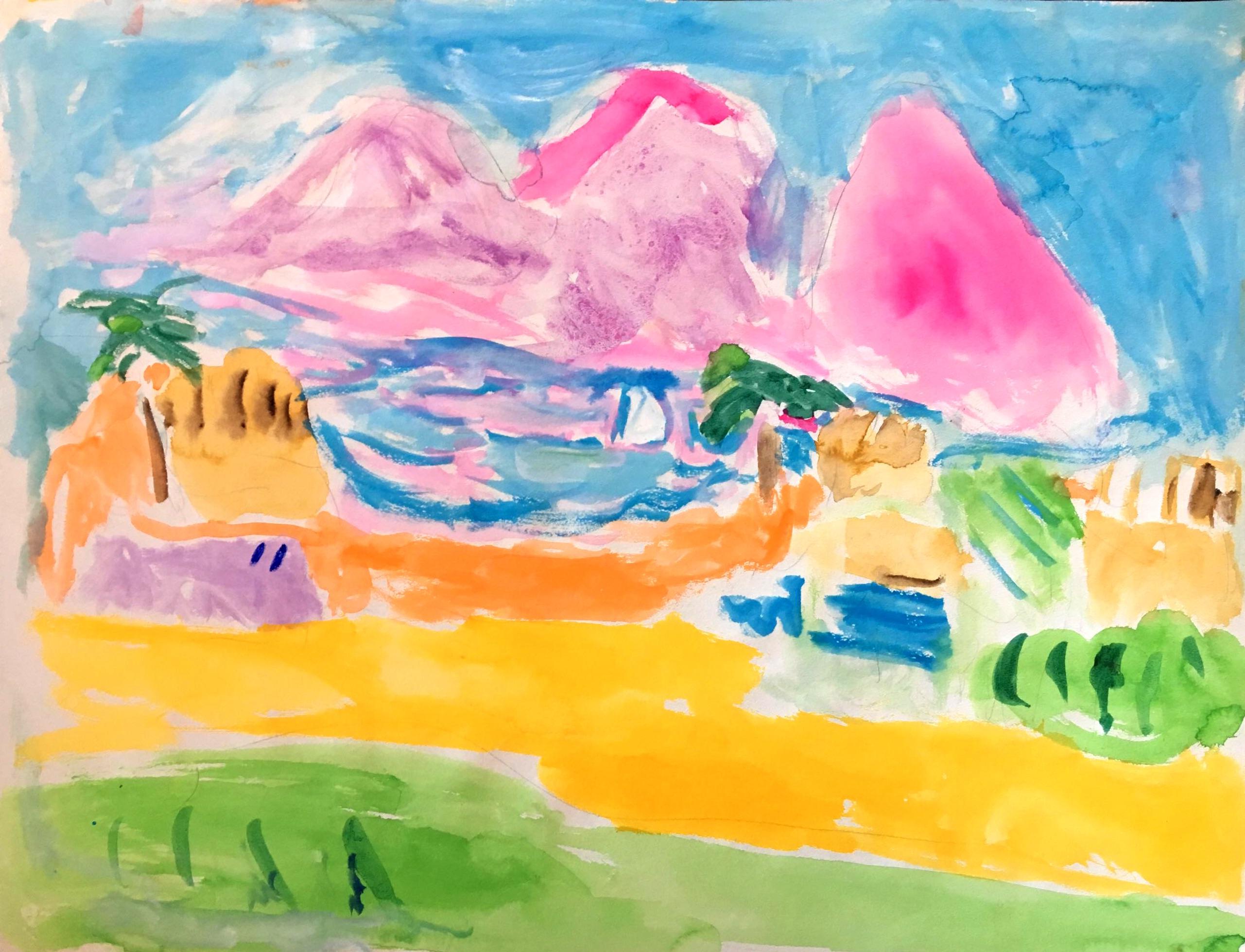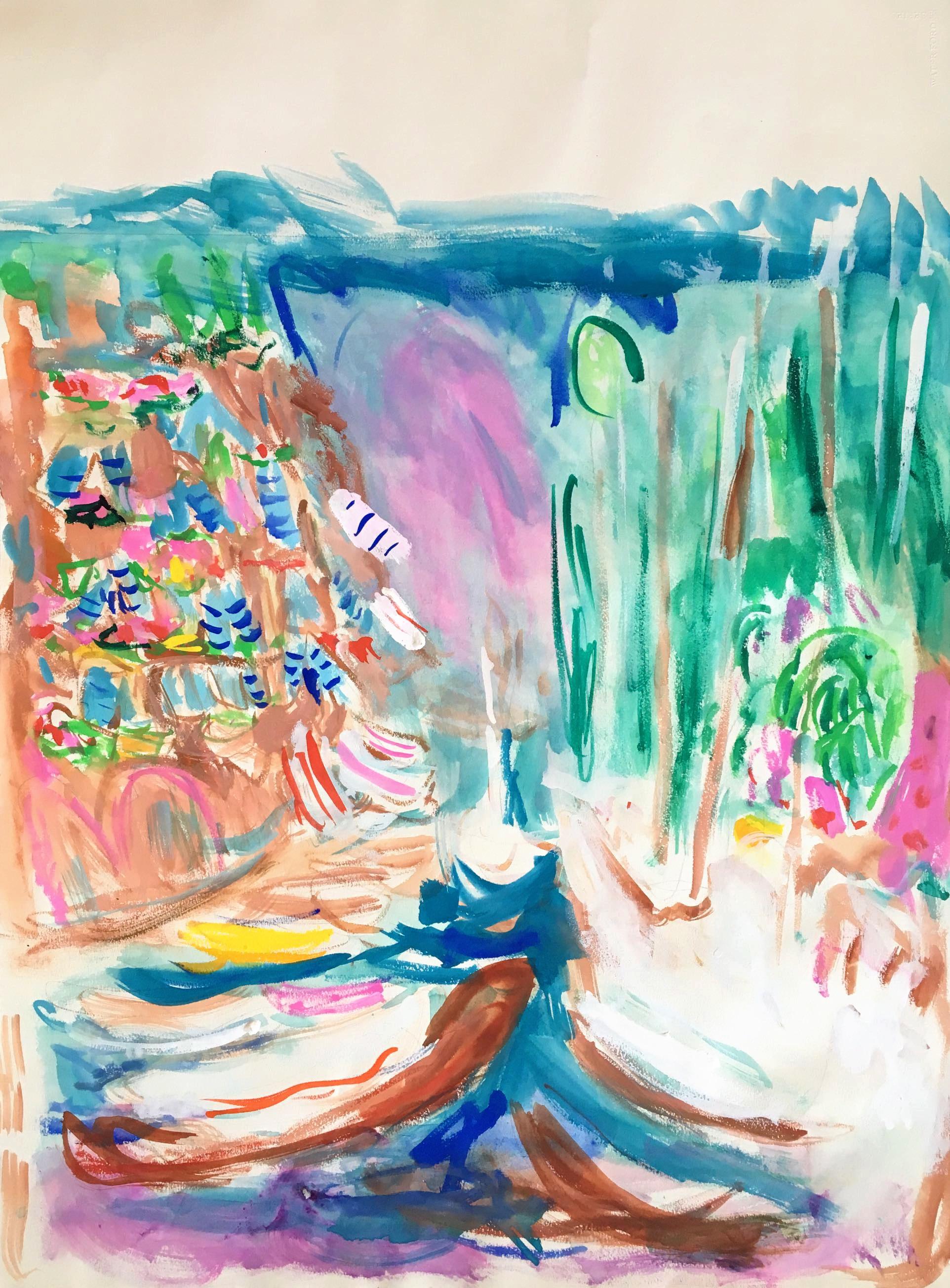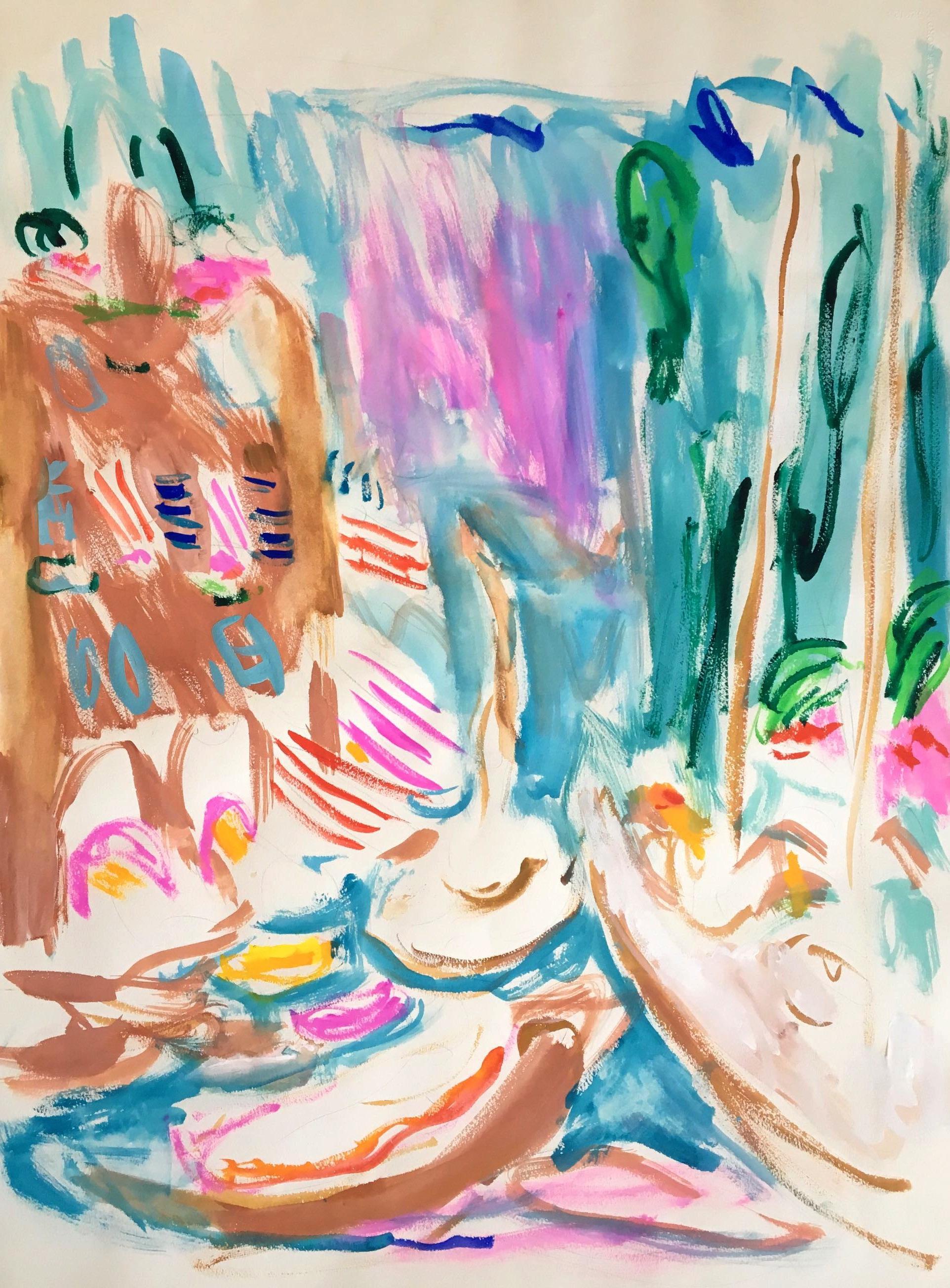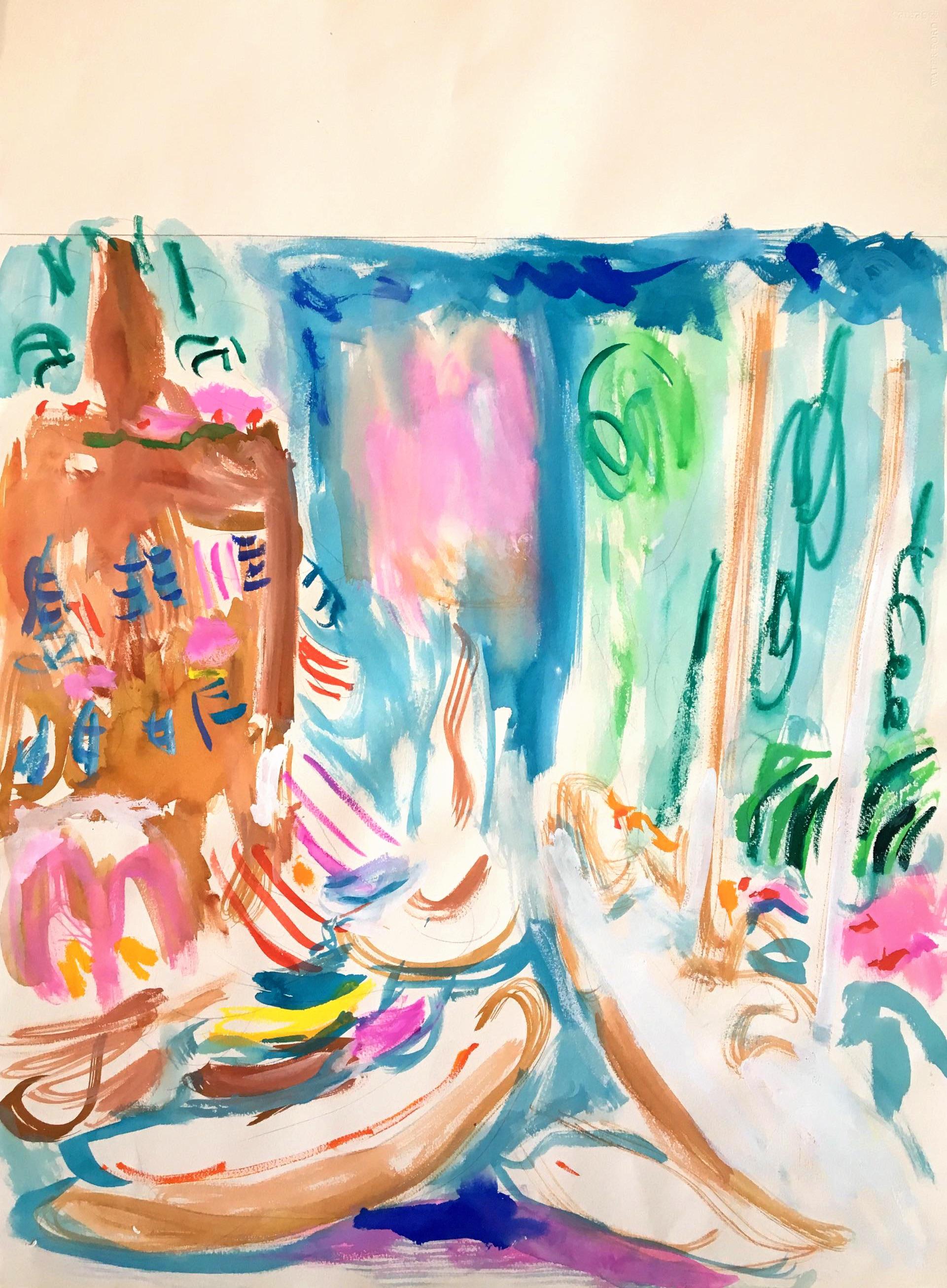Items Similar to Expressionist Watercolor Landscape Painting Jewish Modernist
Want more images or videos?
Request additional images or videos from the seller
1 of 8
Jennings TofelExpressionist Watercolor Landscape Painting Jewish Modernist
About the Item
signed and bears the artist's studio label verso.
Genre: Impressionist
Subject: Landscape
Medium: watercolor
Surface: paper
Country: United States
Dimensions: 11.5 X15.5
Jennings (Yehuda) Tofel (originally Idel Taflewicz or Taflowicz) (born 18 October 1891 in Tomaszów Mazowiecki, Poland, died 7 September 1959 in New York City), Jewish American painter, poet and essayist.
He was born in Tomaszów Mazowiecki (now in Poland) in a Jewish middle-class family as Idel Taflewicz (or Taflowicz). His father Jacob Josef Taflewicz/Taflowicz (b. 1864) was a woman dress’s tailor in Tomaszów Mazowiecki and had his own workshop in home. Jennings’s mother was Alta Haya née Berliner (d. 1899).
After the death of Idel’s mother (1899), his father replaced with the family to Łódź and after some months he returned to the native town Tomaszów Mazowiecki. Idel as a 10-year boy had been injured and a month later his father noted his son’s “raised shoulder”. In his fall, a bone had been fractured, and Idel would have a deformed body for the rest of his life.
In 1905 Jacob Josef Taflewicz immigrated with the family to New York, where they were reunited with other relatives. In New York Idel Taflewicz received the English name Isadore Tofel. Later he changed it into Jennings Tofel, though the Jewish name Yehuda (= Yiddish Idel) was also used.
In New York the artistic talent of young Tofel was recognized, and he entered the Townsend Harris Hall Preparatory School. In 1917 he as Jennings Tofel was represented in a group exhibition at the Whitney Studio called “Introspective Art” (together with Claude Buck, Abraham Harriton, Benjamin Kopman).
His first one-man exhibition came in 1919 at the Bourgeoisie Galleries. That same year, and for the next several years, he was represented in several group exhibitions in the North East, with artists such as Oscar Bluemner, Gaston Lachaise, and Joseph Stella.
In 1925, Tofel left for Europe to further his art studies in France, Italy and Germany, especially in Paris and Berlin. He returned in 1928 to New York. In 1929 Jennings Tofel received a new grant and made his second artistic journey in Europe. While visiting his native city of Tomaszów Mazowiecki, he met his relative, Sura Perla Wajsberg (later Pearl Tofel in U.S.A.), and after a few days of courtship quickly got married.
Jennings and Pearl Tofels returned to New York where they never had a permanent address. In 1931 he had a one-man exhibition at the SPR Gallery, New York and in 1932 the Whitney Museum of American Art purchased “Hagar”. He was also represented in prestigious group exhibitions at the Jewish Museum in New York and the Butler Institute of American Art in Youngstown, Ohio. Tofel was a friend of Georgia O'Keefe and Alfred Stieglitz.
In the last years of his life (1950–1959), Jennings Tofel exhibited at two-year intervals at the Artist’s Gallery. His later years were a time of uninterrupted work. Adventures, confrontations and victories appeared in his art. His color became more fluid and contrasting than ever
Retrospective exhibitions and publications
A retrospective exhibition was held at the Zabriskie Gallery in New York in 1964, and Tofel’s art was represented in the Art Dealers Association of America’s 2nd Annual Show at the Park Bernet Galleries.
In 1976 Arthur Granick, a close personal friend and patron of Jennings Tofel, compiled a beautiful volume which contains 63 colorplates and 129 black-and-white illustrations, including Jennings Tofel’s photographs.
Sources
M. Baigell, Jewish Art in America: An Introduction, Plymouth 2006, pp. XIX, XXIV, 30-32, 46, 79, 118, 122, 125-126, 128, 235, 239-240, 242, 244, 246, 249;
Samantha Baskind, Encyclopedia of Jewish American Artists, Greenwood Press 2006, p. 281;
Arthur Granick, Jennings Tofel, introduction by Alfred Werner, New York 1976, passim (phot.; illustrations);
J. R. Hayes, Jennings Tofel: The Human Form, [in:] T. Fountain (ed.), Jennings Tofel, Mahwah, New Jersey 1984, pp. 8–30;
Jerzy Malinowski, Malarstwo i rzeźba Żydów polskich w XIX i XX wieku [Painting and sculpture of the Polish Jews in the 19th and 20th century], Warszawa 2000, pp. 151, 164-5, 178;
Krzysztof Tomasz Witczak, Słownik Biograficzny Żydów tomaszowskich The Biographical Dictionary of the Jews from Tomaszów Mazowiecki, Łódź – Tomaszów Mazowiecki 2010, ISBN 978-83-7525-358-0, pp. 245–247 (Jennings Tofel's biographical note; phot.).
J. Zilczer, Artist and Patron: The formation of the Hirshhorn Museum's Willem de Kooning collection, “Journal of the History of Collections”.
- Creator:Jennings Tofel (1891-1959, American)
- Dimensions:Height: 11.5 in (29.21 cm)Width: 15.5 in (39.37 cm)
- Medium:
- Movement & Style:
- Period:
- Condition:minor edge toning where it was under mat some tape residue verso.
- Gallery Location:Surfside, FL
- Reference Number:1stDibs: LU38212952512
About the Seller
4.9
Platinum Seller
These expertly vetted sellers are 1stDibs' most experienced sellers and are rated highest by our customers.
Established in 1995
1stDibs seller since 2014
1,546 sales on 1stDibs
Typical response time: 1 hour
- ShippingRetrieving quote...Ships From: Surfside, FL
- Return PolicyA return for this item may be initiated within 3 days of delivery.
More From This SellerView All
- Gouache Watercolor Painting, Nantucket Harbor Boats American Deaf Modernist ArtBy Robert FreimanLocated in Surfside, FLAbstract harbor scene with boats, in bold, vivid colors on heavy mould made paper. Hand signed and dated, 1980 22 X 30 not frame Robert Freiman, deaf from birth, was born in March 1917 in New York City. He attended an oral program near his home and later transferred to the Lexington School for the Deaf when he was six. Early in his childhood, his love for drawing, painting and studying became apparent, and as an adult, he continued his studies in New York at the National Academy of Design, Pratt Institute, the Art Students League and the Parsons School of Design. In Paris, France he studied at the Ecole des Beaux Arts. Bob Freiman was especially focused on painting portraits and figures in motion in various mediums, especially the mixed-media combination of watercolor, acrylic and pen. Among his subjects were acrobats, ballet dancers, cyclists and other athletes. He as well focused on abstracts for a time, discovering new media in his works with quick brushwork and expressive movements. In the latter part of his career, his style became abstract and surreal with images of metaphysical landscapes with architectural elements such as arches, towers, pyramids and castles floating in the air. The famed art critic Pierre Rouve wrote: “It is therefore refreshing to see them revitalized by the colourist wealth and virile handwriting of Robert Freiman, probably the best American water-colorist since John Marin. He worked in Provincetown and Nantucket and regularly exhibited there. He showed at Doll & Richards gallery of Boston alongside John Chetcuti, Lloyd Goodrich, Tod Lindenmuth, William Meyerowitz, Dwight Shepler, Elizabeth O'Neill Verner, Stanley Woodward, Andrew Wyeth, and others. His work bears the influence of the mid century school of Paris in particular Jean Carzou. He was a regular exhibitor at the Sidewalk Art...Category
1980s Expressionist Figurative Paintings
MaterialsWatercolor, Gouache, Archival Paper
- German Expressionist Watercolor Painting Jerusalem Landscape Bezalel Israeli ArtLocated in Surfside, FLThis is a great Judaica Israel landscape. The Old City of Jerusalem during the British Mandate in Palestine. 24.5 x 31 image 16 x 22.5 Isidor Ascheim (איזידור אשהיים; 1891-1968) was a German-born Israeli painter and printmaker. Isidor Ascheim was born in Margonin (present-day Poland) in 1891. He was raised in an Orthodox, Judaic, Jewish family and served during World War I. In 1919-23, Ascheim studied under the German Expressionist Otto Mueller in Breslau and was influenced by Erich Heckel of the Die Brücke (The Bridge) group. He immigrated to Mandate Palestine in 1940 and settled in Jerusalem. He was married to the Israeli painter Margot Lange-Ascheim. He taught at the Bezalel School of Art (amongst his students were David Palombo, David Rakia, Aharon Bezalel, Kopel Gurwin and more) and served as its director for several years. He also taught at the Avni Institute in Tel Aviv along with Moshe Mokadi. Marcel Janco and Aaron Giladi. Ascheim's art is based on a direct impression of nature, life and the human form. His oeuvre represents a continuous connection with nature and the human figure, usually executed with a dark palette, the legacy of his German Expressionist roots. He was a contemporary of Jacob Steinhardt, Mordecai Ardon, Josef Budko and Hermann Struck. Awards and recognition In 1953, Ascheim was a co-recipient of the Dizengoff Prize for Painting. In 1955, he received the Jerusalem Prize for Art. In 1956, he participated in the Venice Biennale, Italy Selected collections Fine Arts Museum of San Francisco Israel Museum, Jerusalem References Isidor Aschheim: Drawings & Prints [Izidor Ashhaim: rishumim ve-hedpesim] . Jerusalem: Israel Museum, 1966. Talpir, Gabriel. "100 Artists in Israel". Tel-Aviv: Gazith Art Publishing, 1971. Isidor Ascheim was born in Margonin, Germany (in what is now Poland) in 1891. His father was a prosperous merchant. In spite of his family’s devoutness, Ascheim had both religious training at home and an education in a German school. In 1903 the family moved to Breslau, where he studied in the gymnasium. When War War I broke out, he was drafted into the German army. In 1918, when the war ended, he began studying art in Breslau, and then in Cracow. In 1939 he made Aliyah to the Land of Israel under the auspices of the Aliyah Bet program. He was caught by the British government and sent to the Atlit detention camp for about seven months. After he was released he settled in Jerusalem and found employment as a lecturer at the “New Bezalel.” In 1946 he married the painter Margot Lange Ascheim. From 1960-1961 he served as director of the “New Bezalel.” Most of Ascheim’s work was in the field of prints. In the 1920s he also produced engravings. Later he specialized in stone printing (lithography), including Biblical subjects, landscapes, and expressionist subjects. In addition, he painted. Education 1919-1923 Art Academy, Breslau, Germany, (now Wroclaw, Poland) with Otto Mueller, an important expressionist painter. Art studies, Professor Pautsch, Academy of Fine Arts, Cracow, Poland Teaching 1943 Bezalel Academy of Art & Design, Jerusalem, was director for some time. 1961-1960 Director, New Bezalel, Jerusalem Collective Annual Exhibition by Palestinian Artists Art Gallery of the ''Habima'' Building, Tel Aviv1944 Artists: Hermann Struck,Moshe Ziffer...Category
1940s Expressionist Landscape Drawings and Watercolors
MaterialsPaper, Watercolor
- European Architectural Colonnaded Arcade Watercolor PaintingBy Boris VassiloffLocated in Surfside, FLBoris Vassiloff, Russian/American (1906 - 2000) Artist Boris Vassiloff was born on March 24, 1906 to Julia Nikolaevna and Boris Ivanovich Vassiloff in Russia. He died peacefully on D...Category
Mid-20th Century Expressionist Landscape Paintings
MaterialsWatercolor, Board
- Pastel, Ink Drawing Rocks And Cloud Landscape Jewish American Modernist WPABy Ben-Zion WeinmanLocated in Surfside, FLMiniature Landscape Provenance: Virginia Field, Arts administrator; New York, N.Y. Assistant director for Asia House gallery. (she was friends with John von Wicht and Andy Warhol) Born in 1897, Ben-Zion Weinman celebrated his European Jewish heritage in his visual works as a sculptor, painter, and printmaker. Influenced by Spinoza, Knut Hamsun, and Wladyslaw Reymont, as well as Hebrew literature, Ben-Zion wrote poetry and essays that, like his visual work, attempt to reveal the deep “connection between man and the divine, and between man and earth.” An emigrant from the Ukraine, he came to the US in 1920. He wrote fairy tales and poems in Hebrew under the name Benzion Weinman, but when he began painting he dropped his last name and hyphenated his first, saying an artist needed only one name. Ben-Zion was a founding member of “The Ten: An Independent Group” The Ten” a 1930’s avant-garde group, Painted on anything handy. Ben-Zion often used cabinet doors (panels) in his work. Other members of group included Ilya Bolotowsky, Lee Gatch, Adolf Gottlieb, Louis Harris, Yankel Kufeld, Marcus Rothkowitz (later known as Mark Rothko), Louis Schanker, and Joseph Solman. The Art of “The Ten” was generally described as expressionist, as this style offered the best link between modernism and social art. Their exhibition at the Mercury Gallery in New York held at the same time as the Whitney Annual Exhibition of Contemporary American Painting, included a manifesto concentrating on aesthetic questions and criticisms of the conservative definition of modern art imposed by the Whitney. Ben-Zion’s work was quickly noticed. The New York Sun said he painted “furiously” and called him “the farthest along of the lot.” And the triptych, “The Glory of War,” was described by Art News as “resounding.” By 1939, The Ten disbanded because most of the members found individual galleries to represent their work. Ben-Zion had his first one-man show at the Artist’s Gallery in Greenwich Village and J.B. Neumann, the highly esteemed European art dealer who introduced Paul Klee, (among others) to America, purchased several of Ben-Zion’s drawings. Curt Valentin, another well-known dealer, exhibited groups of his drawings and undertook the printing of four portfolios of etchings, each composed of Ben-Zion’s biblical themes. Ben-Zion’s work is represented in many museums throughout the country including the Metropolitan, the Whitney, and the Museum of Modern Art in New York, the Art Institute of Chicago, the Philadelphia Museum of Art and the Phillips Collection, Washington. The Jewish Museum in New York opened in 1948 with a Ben-Zion exhibition. “Ben-Zion has his hands on the pulse of the common man and his natural world” As he emerged as an artist Ben-Zion never lost his gift for presenting the ordinary in ways that are vital, fresh and filled with emotions that are somber and exhilarating, joyous and thoughtful, and ultimately, filled with extraordinary poetic simplicity. Ben-Zion consistently threaded certain subject matter—nature, still life, the human figure, the Hebrew Bible, and the Jewish people—into his work throughout his life. "In all his work a profound human feeling remains. Sea and sky, even sheaves of wheat acquire a monolithic beauty and simplicity which delineates the transient as a reflection of the eternal. This sensitive inter- mingling of the physical and metaphysical is one of the most enduring features of Ben-Zion's works." (Excerpt from Stephen Kayser, “Biblical Paintings,” The Jewish Museum Catalogue, 1952). Along with ben Shahn, William Gropper, Chaim Gross and Abraham Rattner he was an influential mid century Jewish American...Category
Mid-20th Century Expressionist Landscape Drawings and Watercolors
MaterialsPastel, Ink, Watercolor
- Algerian French Vibrant Colorful Expressionist Beach Scene Oil Pastel DrawingBy Armand Henri NakacheLocated in Surfside, FLArmand Nakache was the foremost champion of Expressionism in France, an area unfairly shunned by a society more attracted to the charms of classical painting, Impressionism, Post-Imp...Category
20th Century Expressionist Landscape Drawings and Watercolors
MaterialsPaper, Oil Pastel, Pastel
- Israeli Modernist Safed Synagogue Interior Folk Art Watercolor PaintingBy Zvi EhrmanLocated in Surfside, FLIn this piece the artist choice of colors is vibrant, and there is minimal blending of them. The artist takes a naive, Folk Art approach at rendering the subject simplifying the figu...Category
Mid-20th Century Modern Landscape Drawings and Watercolors
MaterialsPaper, Watercolor
You May Also Like
- Mediterranean Seascape 553, 2000sBy Bob Paul KaneLocated in Quogue, NYWatercolor on paperCategory
Early 2000s Expressionist Landscape Drawings and Watercolors
MaterialsPaper, Watercolor
- Untitled 525, 1980sBy Bob Paul KaneLocated in Quogue, NYWatercolor on paperCategory
1980s Expressionist Landscape Drawings and Watercolors
MaterialsPaper, Watercolor
- Harbor 555, 2002By Bob Paul KaneLocated in Quogue, NYWatercolor on paperCategory
Early 2000s Expressionist Landscape Drawings and Watercolors
MaterialsPaper, Watercolor
- Harbor 552, 2000sBy Bob Paul KaneLocated in Quogue, NYWatercolor on paperCategory
Early 2000s Expressionist Landscape Drawings and Watercolors
MaterialsPaper, Watercolor
- Harbor 549, 2000sBy Bob Paul KaneLocated in Quogue, NYWatercolor on paperCategory
Early 2000s Expressionist Landscape Drawings and Watercolors
MaterialsPaper, Watercolor
- View of the Fjord Blick auf die Förde - Landscape Fjord GermanyBy Erich HeckelLocated in London, GBThis watercolour is hand signed and dated in pencil by the artist "Heckel 42" [1942] in the lower right image. It is also hand titled in pencil “Blick auf die Förde” in the lower ri...Category
1940s Expressionist Landscape Drawings and Watercolors
MaterialsPaper, Watercolor, Pencil
Recently Viewed
View AllMore Ways To Browse
Oscar Alta
J Gaston Painting
Italian Jewish
Samantha French
Vintage Native American Dress
Italian Genre And History Painting
Joseph Greenwood
De Kooning M
Vintage Native American Photographs
Expressionist Painting And Woman
Vintage Warszawa
Pablo Picasso Hand Signed Posters
Kew Gardens Painting
Mid Century Religious Painting Abstract
Greensboro Nc
Relief Artwork Vintage
Postcard Lot
Boxing Ring Painting





